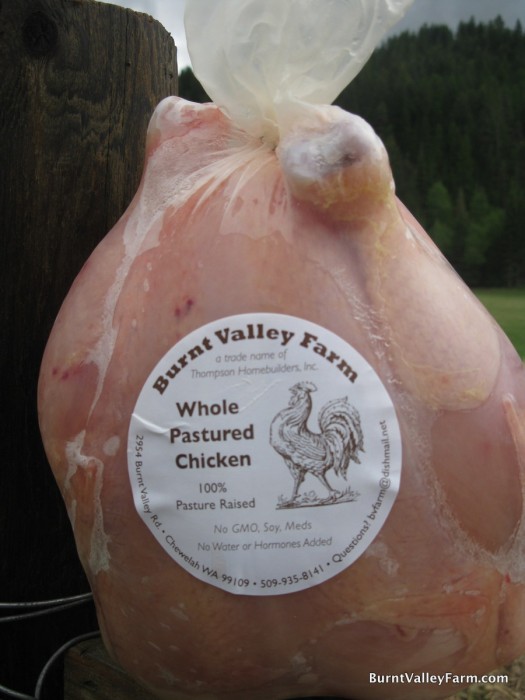
What is “pastured” chicken and why should you try it? It’s all about the life of the chicken. A happy, healthy chicken means a tasty, nourishing meal for you and me.
The story in snap-shot: “Pastured” means the chickens live out on the pasture, directly on the grass. The feed, fresh air, water and sunshine, grass and insects provide quality nourishment and a low-stress life with a natural flock. Low stress in a chicken’s life leads to low levels of stress hormones in the meat. Of course, our meat chickens get their own custom feed with only quality ingredients (NO corn, soy, GMO, medications or hormones). It all adds up to meat that is delicious with a ‘real-chicken’ texture and is so good for you.
And the full-length feature motion picture: Upon the chicks arrival at the Chewelah Post Office, we get the 6:00am call. Either the President (Pete) or VP (Joan) drive the Chicken Department Head (13 year-old Robbie) into town to pick up about 160 chicks. Having prepared the brooder houses, Robbie dips the beak of each chick in water (they need to learn that water is good and they should drink more of it) and sets them in. Everything must be just right. Temperature. Feed. Floor. Water. Space. Light. Chicks are fragile and we watch them carefully.
At around 3 weeks old, the chicks (now pullets) are put in the chicken tractors on the pasture. Following Joel Salatin’s design, Pete and the boys built 4 chicken tractors. These movable cages are 14×6 and about 2 feet tall, allowing plenty of space for the chickens to stretch. Last year’s improvements included a watering system that allows the chickens to drink from metal nipples in PVC pipe wrapped around the inside of the enclosure. The water comes from a barrel through the pipe to the chickens. This way, they always have fresh, clean water. Our Welding Department Head, Isaac (18) built new feeders that can be opened or closed to the chickens, enabling us to control the speed of growth. The Cornish Cross breed makes a tasty, tender meat, but if they grow too fast, they get too heavy and their legs can’t hold them up. We avoid that with careful monitoring.
Every day, Robbie pulls the chicken tractors (with our little blue Holland tractor) a few feet to fresh grass. The back is unhinged so that if a chicken is lazy or not paying attention, it just pops out the back and then is herded back in. Usually, they clue in and walk along while the tractor is moved. With half the chicken tractor enclosed with sheet metal, there is shade and shelter from the elements. The other half is kept secure with chicken wire so the chickens get the fresh breezes.
When the chickens are ready, usually about 8 or 9 weeks old, it’s processing day. In Stevens County, we are thankful for the Community Agriculture Development Center. The CADC maintains the mobile poultry processing unit, available to small poultry farmers. Everything you need to process lots of chickens efficiently is contained in this trailer: butcher cones, scalder, plucker, stainless steel counters and sinks, hoses, and chilling barrels. On the first day of the season, inspectors from the USDA stop by and make sure all is safe and done properly.
And the team goes to work. Pete and Robbie bring chickens from the pasture in crates and the process begins. (You may want to skip this paragraph) Pete puts them in the cones head-first and carefully cuts the artery in the neck. When they’ve bled out, Robbie puts about 4 at a time in the scalder, and after that, the plucker. So far, it all happens in the open back end of the trailer. Then, it’s through the window to Noah and Joan at the eviscerating station. We take off the heads and feet and clean out the cavity. (Is this more than you wanted to know?) After quality control inspection (Joan), they go into the chilling barrels. (We go through a LOT of ice!) Once chilled, they sit on racks for a bit to dry. Then, it’s Becca’s turn. She has the important job of bagging, shrink-wrapping, weighing, labeling and delivering to the freezer.
Processing chicken isn’t exactly fun, but we’ve created some of those family-bonding memories on those days. We always take a mid-morning brunch break with berry cobbler, bacon (usually our own pork) and eggs (always our own!), and really good coffee. Hopefully, there’s enough time after everything’s done to take the whole family to the lake.
So, there’s that beautiful chicken, plump and delicious, with an official Burnt Valley Farm label. There’s a feeling of satisfaction, producing something of quality that is highly valued by people who know the difference.